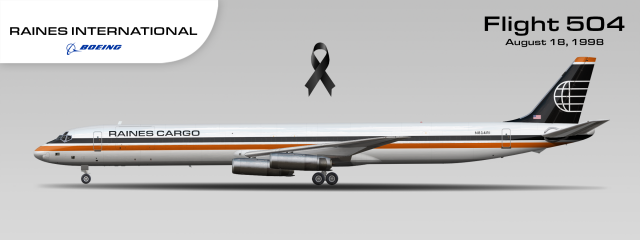
The Norfolk Air Disaster - Douglas DC-8-63F (Flight 504)
- Owner: crossfire (View all images and albums)
- Uploaded: Jun 23 2022 09:23 AM
- Views: 567
- Album Raines Air Systems: A Complete History

The late 1990's were an uncertain time for Raines. On September 7th, 1995, Charles Raines would pass away from a stroke at his home. Ed Collins would temporarily assume the position of CEO but would step down due to the progression of his lung cancer. In October of 1996, Al Bangh was elected by shareholders to become the new CEO of Raines Air Systems.
Bangh's main concern when it came to strategy was to maximize profits and thus rapidly expand. He did this by ramping up flights and opening new hubs in Miami and New York. Some of the new changes would anger employees, as now they were working longer, more stressful hours with no pay raise to compensate. In late 1997, a pilot union attempted to integrate Raines pilots, but this was blocked by Raines management much to the protest of the pilot themselves. These issues would all culminate on one fateful day on August 16th, 1998.
Flight 504 was operated by a Douglas DC-8-63 registered N814RI. It previously flew for Japan Airlines and Trans International before arriving at Raines in 1989. The flight crew consisted of Captain James Farkley, First Officer Robert Schorn and Flight Engineer Vernon Padfield. The flight was set to fly from Norfolk to Miami after previous flights in Dallas to St Louis, St Louis to Willow Run and Willow Run to Atlanta. Flight 504 was originally supposed to be flown by another aircraft and crew, however due to technical problems the accident aircraft and crew was ferried to Norfolk despite the fact that Atlanta was supposed to be the end of their shift.
Flight 504 took off from Norfolk at 14:06 EST. 4 minutes after takeoff, a loud bang was heard. A fire alarm for engine 3 sounded a few seconds later. Instead of pulling the lever, the flight crew tried to cut fuel to the engine supposedly to stop the fire. When that failed to stop it, Captain Farkley declared an emergency 3 minutes later. As the fight turned back to Norfolk, witnesses on the ground said that engine 3 had visible fire that trailed the wing. The fire burned hot and began to weaken the wing. As the aircraft turned to runway 5 for landing, the right wing finally gave way near engine 3, and the aircraft crashed 2 miles from the runway into a children's baseball field. The aircraft caught fire and all three crew members died.
The NTSB would launch an investigation soon after. A year later, the organization would launch it's findings in the final report. The engine failed due to a combustor dislodging due to faulty maintenance, causing the turbine to shatter and debris to puncture the wing. Fuel spilled out and made contact with the engine causing it to light. The slow speed of the aircraft caused more fuel to compile near the engine, worsening the fire. The impaired reaction time of the crew was the result of lack of rest thus leading to impaired judgement. Shortly after the report was released, the FAA fined Raines Air Systems $785,000.
The accident would mark the nail in the coffin for the financial disaster Raines would face in the coming years.

 Sign In
Sign In Create Account
Create Account










